Kate Forsyth's Blog, page 37
July 31, 2015
BOOK LIST: My Seven Favourite Academic Studies of Fairy & Folk tales
[image error]
1. The Uses of Enchantment: The Meaning & Importance of Fairy Tales by Bruno Bettelheim
First published in 1975, this is one of the most important early books on fairy tales. It is stuffed full of ideas, but must be read with a caveat in mind. Bettelheim was a Freudian psychoanalyst which means that some of his interpretations seem very out-of-date nowadays. Also, he was drawing on limited scholarship because he was essentially the man who sparked the later intense academic interest in the subject. His reputation has also been tarnished by his suicide and the accusations of child abuse that followed. Nonetheless, he was a man of vision that helped rescue fairy tales from the dust balls under a child’s bed. He says that fairy tales teach us ‘that a struggle against severe difficulties in life is unavoidable … but that if one … steadfastly meets unexpected and often unjust hardships, one masters all obstacles and at the end emerges victorious.’
[image error]
2. Why Fairy Tales Stick: The Evolution and Relevance of A Genre by Jack Zipes
All of Jack Zipes’s books are eloquent, insightful and cleverly argued, but this is my favourite because it is so accessible to people outside arcane academic circles. He has the ability to communicate clearly and yet with great depth of scholarship. And he is interested in the socio-historical background of the tales as well as what they may mean. He says: ‘As we know, tales do not only speak to us, they inhabit us and become relevant in our struggles to resolve conflicts that endanger our happiness.’
Other books by Zipes that I would thoroughly recommend are The Irresistible Fairy Tale: The Cultural and Social History of A Genre , which builds on Why Fairy Tales Stick; and Breaking the Magic Spell: Radical Theories of Folk and Fairy Tales.
[image error]
3 . From the Beast to the Blonde: On Fairy Tales and their Tellers by Marina Warner
I cannot tell you how much I love this book. I have read it so many times I know parts of it off by heart. It’s a massive work of scholarship that looks at the history and meaning of fairy tales with a strong feminist and revisionist slant. This is a must-read. She says: ‘The marvels and prodigies, the seven-league boots and enchanted mirrors, the talking animals, the heroes and heroines changed into frogs or bears or cats, the golden eggs and everflowing supplies of porridge, the stars on the brow of the good sister and the donkeytail sprouting on the brow of the bad – all the wonders that create the atmosphere of fairy tale disrupt the apprehensible world in order to open spaces for dreaming alternatives. The verb ‘to wonder communicates the receptive state of marvelling as well as the active desire to know, to inquire, and as such it defines very well at least two characteristics of the traditional fairy tale: pleasure in the fantatsic, curiosity about the real. The dimension of wonder creates a huge theatre of possibility in the stories: anything can happen. This very boundlessness serves the moral purpose of the tales, which is precisely to teach where boundaries lie.’
[image error]
4. The Witch Must Die: The Hidden Meaning of Fairy Tales by Sheldon Cashdan
This book sets out to explore how fairy tales can help children deal with psychological conflicts by projecting their own internal struggles onto the characters in the stories. In this way, Cashdan is building on Bettelheim’s legacy. He divides the stories based upon vices such as vanity, gluttony, deceit, greed and lust, which is interesting but can sometimes be a little simplistic. Nonetheless, it’s a fascinating read. He says: ‘Beyond the chase scenes and lastminute rescues are serious dramas that reflect events taking place in the child’s inner world. Wheareas the initial attraction of a fairy tale may lie in its ability to enchant and entertain us, its lasting value lies in its power to help children deal with the internal conflicts they face in the course of growing up.’
[image error]
5. The Hard Facts of the Grimms’ Fairy Tales by Maria Tatar
Murder, mutilation, cannibalism, infanticide and incest: the darker side of the Grimm fairy tales are examined in this fascinating book. She looks at the countless wicked women in a chapter entitled ‘Stepmothers and Other Ogres’ and the beastly men in ‘Bluebeard and Other Monsters’ – it’s a racy, clever, and intriguing read. She says: fairy tales are up close and personal, mixing fact with fiction to tell us about our deepest anxieties and desires. They offer roadmaps pointing the way to romance and riches, power and privilege, and most importantly, a way out of the woods, back to the safety and security of home.’
[image error]
6. Grimms' Bad Girls and Bold Boys: The Moral & Social Vision of the Tales by Ruth B. Bottigheimer
First published in 1987, this is a fascinating and insightful look at the history of the Grimm brothers’ fairy tales, and some of the key motifs and story patterns that emerge. She also examines the various different editions and shows how the Grimm brothers had changed the stories over subsequent editions to better suit their devout, middle-class principles. She says: ‘People tell tales: peasants and artisans, lords and ladies, mothers and fathers, priests and preachers, girls and boys. The literate read aloud, the gifted recount. Over and over people tell tales whose contains seem the same but that nonetheless differs in profound ways.’
[image error]
7. Clever Maids: The Secret History of the Grimm Fairy Tales by Valerie Paradiz
It was this book that inspired me to write my novel ‘The Wild Girl’. It tells the story of the forgotten women who were the primary oral source of the stories the Grimm brothers collected. The book is wonderfully accessible, and draws upon the tales themselves in a way which I think worked wonderfully. She says: ‘Few readers know that more than half of the 210 fairy tales included in the Grimm anthologies had a woman’s hand in them.’
I hope you find this post insightful! Please leave a comment - I love to know what you think
June 5, 2015
Creating Secondary Worlds

One of the great pleasures of writing a fantasy novel is creating the secondary world in which your story will inhabit.

In the contemporary fiction genre, the writer knows the religious, political, historical, and cultural background of the society already
A fantasy writer must construct the society from the very foundations.
E.M. Forster wrote in ‘Aspects Of the Novel’, that ‘What does fantasy ask of us? It asks us to pay something extra. It compels ask to make an adjustment that is different to an adjustment require by a work of art, to an additional adjustment. The other novelists say, “here is something that might occur in your lives”, the fantasist “Here is something that could not occur.”
[image error]
The extra coin that E.M. Forster says must be paid by the reader of a work of fantasy is the suspension of disbelief.
By agreeing to put aside our inherent scepticism, we are opening the doors of our imagination and inviting in beauty, terror, strangeness, the marvellous and the miraculous. We are allowing ourselves to wonder whether the world may not be a different place to what we believe it to be. This can be an uncomfortable experience, no doubt, but also a liberating one.
The extra coin that a writer of fantasy must pay is the painful stretching of their own imaginations and knowledge. A good writer of fantasy is one which constructs their impossible world with great care.
They must know the spiritual beliefs of their people, and the tension which inevitably arise between those who believe differently.
They must know the history, the language, the culture, the landscape, the flora and fauna – and it is not enough to call a rat a “sleghg”, or some other unpronounceable made-up name!
Nor is it enough just to give your characters a sword and a cloak and a horse and a dragon to fight, and think that your work is done. Especially if your hero says ‘OK’ and ‘See ya later.’
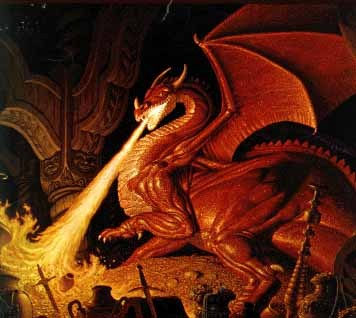
Readers of fantasy are usually avid readers with excellent educations. When you have read a thousand fantasy books, the ones you remember are the ones which enter into your dreams and inhabit your waking life, ones which seem more real than your own life, ones which give you a language to express your own inexpressible fears and desires.
In order to create this vividness, this intensity of feeling in the reader, a writer must spend the time getting to know their created world as well, if not better, than the world in which we all live.
How they would speak, what clothes do they wear, have they discovered how to magnetise lodestones yet, and do they knew the recipe for gunpowder?

Is the world you are creating set on our planet in the past, or is it set on our planet as it may have been if things had happened differently, or is it on a different planet altogether?
Who holds the power in your created world? Who desires to?
What is the primary source of money?
What do people eat for breakfast?
What kind of underwear do they wear?
What do people say when they hammer their thumb instead of the nail?
What god do they call to in their despair?
The sorts of questions you can ask yourself when constructing a fantasy world are endless, and endlessly fascinating. Much of it may not find its way into the narrative, for after all, you are not writing a traveller’s guidebook, but a story.
It is the story which will compel your reader’s interest. Yet if you do not do the ground-work, you will not be able to understand what forces drive your characters, and it is your characters that make the story come alive.
June 4, 2015
LETTER FROM A FAN: How books can change a life

A VINTAGE POST TO CELEBRATE THE BOLD NEW COVERS FOR THE WITCHES OF EILEANAN
Sometimes, a writer can begin to lose heart.
The literary industry is not always an easy one to work in. Terrible novels can become major blockbusters, while wonderful novels languish on bookshop shelves. One or two authors can win every award in the country, while others are passed over again and again. It’s hard at times to maintain faith in yourself and your work.
At times like this, it can really help for a writer to be reminded that what we do has value. Books can inspire, invigorate, comfort and console.
And so can letters from readers.
This e-mail came at a time when I was overwhelmed by the difficulties of juggling work and family, weighed down by impossible deadlines, and disheartened by the struggle to have my voice being heard in the great clamour of the international publishing scene.
I’d like to share it with you.
Sent: Saturday, 1 September 2012 9:12 AM
Subject: About time I sent this
Let me start by introducing myself. My name is Mitchell, and I was born in Brisbane. I lived much of my young life in a small town called Coppa Bella, and later moved to yet another small town, Keppel Sands. I am now 23 years old, and I have been living in Rockhampton since I was 19. Because of the distance between my home and school life, I found myself very isolated from people my age. I didn't like the people I lived with, and I never had much chance to make a lasting connection with the people I went to school with. I was also in special education for high functioning Autism, so I felt even more isolated from everyone else.
Your books helped me through this time, and I'd like to thank you. I'm sorry for the length of this email, but I'd like to explain how 'The Witches of Eileanan' changed my life.
When I was 14, my teachers were concerned I was dyslectic. I still couldn't read or write. I could draw, and when I'd get frustrated in class, not being able to follow the page with everyone else, I'd draw dragons, monsters, winged heroes, horned demons. Sometimes I got so depressed with being 'stupid' that my drawings became horror stories instead of adventures.
One day, my stepdad came home and dropped a book on my work desk while I was drawing. It was ‘Dragonclaw’.
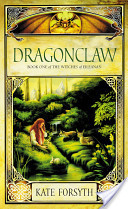
I didn't understand at the time, but now I see just how perceptive the guy had been, and I feel very silly for only just now realizing it. He put the dots together and realized that my 'learning disability' was just a lack of interest. Books for my age were boring to me, and class subjects were worse. All my teachers stumped and my stepdad the simple train driver had figured it out.
I still had trouble reading, since I hadn't done it much, but I learned pretty quick. A lot of the words escaped me for a few years, especially the Scottish stuff. I tried putting in placeholder words, like King instead of Righ, and plenty of times I put the wrong face to a person, and didn't realize it until years later when I reread them. Hell, Margrit of Arran ended up looking like one of the Yugioh villains, which was on after school at the time. And when Rhiannon's Ride came around, Lord Fettercaine somehow materialized as "John McCain in a sweater vest".
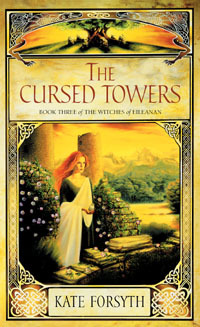
Eventually, I was asking my stepdad for the second one. Then the third. And when they didn't arrive fast enough, I'd check the school library. And that was soon tapped out, so I was so excited to see a box in the back of the library labeled 'Fiction'. When they told me it wouldn't be on the shelves for a few days, I was restless. And when those were all read, my mum would take me along to the public library when she went to get her hair done, and just leave me there for an hour while she was across the street, so I could pick out a dozen or so books to take. She never minded paying. And while some of my teachers felt the books were too violent for a 14 year old, they would let me read in class if I finished my school work. It was the best way to get me working.
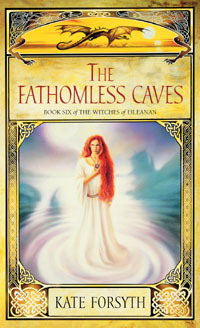
There was one problem though. I could never get The Heart of Stars. I was so excited when I found out there was a trilogy after the Witches of Eileanan, and I'd reread all 6 books every year or so.
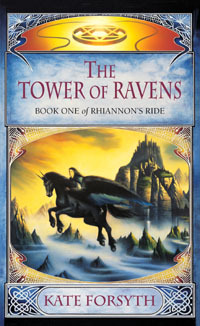
I was an adult at this point, and didn't see my mum or stepdad as often as I'd have liked. But one day I randomly ran into my mum in town, and we drifted about all day, wasting money, doing some menial shopping and almost getting in a car accident because of her horrid red jeep. Before we separated, she got ‘Rhiannon’s Ride’ out of her purse, just now remembering. I loved my mother so much, and I was closer to her that day then I'd ever been.
Three days later, my stepfather picked me up, drove me to their home, and told me and my brother she had died of a heart attack. I had the book in my hands when I found out, and I didn't open it for a whole year afterwards.
When I finally finished it and tracked down ‘The Shining City’, Lewen being turned against Rhiannon while she awaited trial hit me so hard I put the book away again, and tried 3 more times over the years to finish. Each time, I couldn't. It was too sad, but those books were so close to me, I just couldn't leave them unfinished.
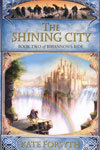
I took a 10 hour train ride to visit family and forced myself to finish the book, and I remember turning the last page and closing it just as the speakers announced my stop. I felt lighter then I had in years as I stepped out of the train. I had gotten on when it was dark and empty outside the station, and had spent the entirety of the trip alone, in an empty cart, without a single sign of life outside the dark window. When I arrived, it was to the very beginnings of a cloudless sunrise, with the train station workers and early passengers just now seeming to rouse. It had felt like a literal journey for me, finishing this book, and leaving that dark and silent train to call a taxi felt a lot like leaving behind all that ickiness that had kept me from reading for so long. I felt like Isabeau returning from The Spine of the World, stronger now for facing myself, but knowing my quest wasn't over.
‘Heart of Stars’ would continue to allude me. It was the last book. I couldn't stop now. It was never in stock, even online, and when it was, it wouldn't ship here. I tried audio book stores online, e-books that I couldn't even use since I had no smart phone, and every garage sale and second hand store I came across would get raided. After a while, I gave up.
Then, one day, I was walking down the street, after stashing my broken bike in some bushes, not caring what happened to it. I was broke, looking at a long walk home, the humidity was dragging me down and it was already starting to rain. It was everything you'd picture from one of those soul crushingly bad days, where absolutely everything that could go wrong did. I went into a random store to wait and see if the rain would stop and to hide in the air conditioning, and ended up talking to the clerk for about 20 minutes.
It was a tiny second hand book store, and the entire time, I never noticed the copy of ‘Heart of Stars’ behind the woman, right in my sights. It was 15 dollars, and I felt my heart about to implode when I saw about 8 bucks worth of silver coins in my wallet. I felt like this was the last cruel joke that today would throw at me to end it's fun. The Coup De Grace. As if I weren't already so low, now fate dangles this just out of my reach, and if my luck held like this, it wouldn't be here when I get paid in a week. I was ready to just sulk off out into the rain, trudge into my place and collapse with the bottle of bourbon I keep in the pantry.
I guess the nice woman who owned the store knew the feeling, because she bagged it for me and asked for 5 dollars.
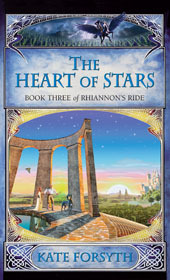
Kate, you're books introduced me to reading, and they helped make me the person I am today. Finally completing the series after all this time feels like a very deep, very important part of me has also been completed. Thank you so much for helping me grow up and discover myself Kate. You loaned me your Muse until I could make one for myself, and I'll always cherish the memories these wonderful books gave me. You are a wonderful writer, and I'm glad I had your works in my life.
Just a fan from Rockhampton
This was my answer:
Dear Mitchell
I had a big lump in my throat reading your message, and my eyes were stinging with tears. Thank you so much! I don’t know if you realise how much a message like yours means to a writer. We spend our time labouring in the dark, hoping to strike a spark, hoping we can kindle some kind of light for others … and your message shows me so clearly that for you, at least, I succeeded. I have printed your message out – I will treasure it always.
I wonder if you would allow me to post your message on my blog? It just seems so special, so beautiful, that I want to share it --- perhaps even boast about it a little. I feel it’s so deeply heartfelt and personal that perhaps you will not wish to share it with others, and, if so, I perfectly understand.
Either way, I just wanted to thank you for taking the time, and for reminding me why I keep struggling on, trying to write the stories I want to write. I hope you’ll go on and read more of my books – and many other books too.
Wishing you all the best, with all my heart
Kate
May 31, 2015
SPOTLIGHT: The story behind how I first got published
Today (1 June 2015) marks eighteen years since my first novel was published!
The book was called DRAGONCLAW, and it was the first in the series of heroic fantasy novels called THE WITCHES OF EILEANAN.
To celebrate my 18 Year Anniversary, Random House Australia have re-launched the whole series with a bold and fresh new look, and we are offering one lucky reader the chance to win the whole set, signed by me.

Here is the story of how THE WITCHES OF EILEANAN came to be published:
I’ve always wanted to be a writer – it’s the only thing I’ve ever wanted to be.

A novel I wrote when I was 15
All through my childhood I wrote many poems and novels, and sent out my first manuscript when I was sixteen – it was handwritten, in my very childish handwriting, on loose foolscap pages. I didn’t know any better! Well, I didn’t have a typewriter and computers were barely invented. It was rejected, of course, but came back with a lovely letter saying that I clearly had talent and must keep writing.
So I did. I laboured over a magic realism novel all though my early 20s, while working as a journalist, and began to have poems and stories published. I sent out my novel a few times, and it was almost published three times, but fell through every time, much to my despair.
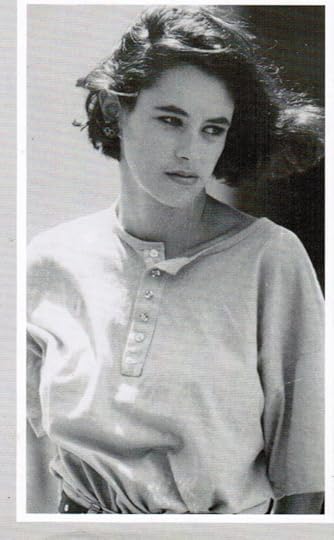
Me in my 20s
At the age of 25 I had a quarter-life crisis. I decided to give myself five years, to pour all my energy into getting a book published, but that I’d have to reassess my life if I couldn’t get published by the age of 30.
I quit my job as a journalist and began freelancing to support myself, and I applied to do my Masters of Arts in Writing, using the magic realism novel I had been working on as my thesis.
I began writing the first draft of Dragonclaw while I was studying for my first year exams, probably in reaction to the “fictive discourses” we were told to construct in our writing classes. About 50,000 words into the first draft, I sent off a few sample chapters to Gaby Naher at Hickson Associates.
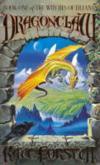
She came back the next day, saying she loved it, and when could I get her a complete manuscript? I wrote madly for the next few months (practically ignoring my studies and work commitments).
I finished the first draft, she put it up for auction, and I signed with Random House by the end of the month. This made me particularly happy, since it was two days before my 30th birthday.
I made my deadline by a whisker!
Dragonclaw has gone on to be sold in the US, Germany, Russia, and Japan, and I have been a full-time writer ever since.
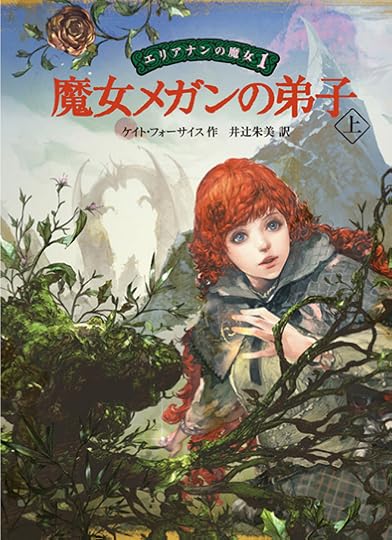
Dragonclaw changed my life forever!
May 7, 2015
WRITING ADVICE from Kimberley Freeman
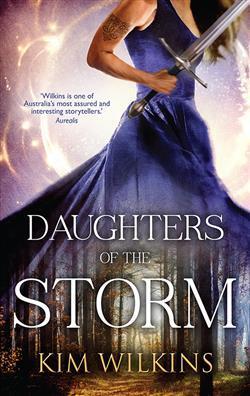
As you will know, Kim Wilkins is the author of some of my all-time favourite books, including 'Angel of Ruin' and 'The Autumn Castle' - books which entwine history and the supernatural with intoxicating results.
[image error]
In recent times, she has been writing books with a greater emphasis on romance and suspense rather than magic, under the name Kimberley Freeman, using her beloved grandmother's surname. I love these books just as much as I do her earlier books. Although they do not have that chilling supernatural twist, they are still books that utterly refuse to be put down - utterly compelling and readable.
Her most recent novel, 'Lighthouse Bay' was one of the Best Books I Read in 2012, while I can also strongly recommend her previous book, 'Wildflower Hill'.
[image error]
Born in London, Kim grew up in Brisbane and has degrees in English Literature and Creative Writing. I first met her in Melbourne when both of our first books were short-listed for the Aurealis Prize for Excellence in Speculative Fiction. Kim won, drat her.
Since then we try and see each other whenever we can. We always talk long and hard about the craft of writing, something we both feel very passionately about.
[image error]
Here are Kim's top writing tips:
• Look to your verbs. If you read a page back and it seems lifeless and flabby, find every verb on the page and see if you can improve it. Make a point of collecting great verbs every time you read or watch a movie or have a conversation. Verbs like gasp, surge, quiver, and drench work so hard. Verbs are the muscle of a sentence, and can punch up dull writing in a moment.
• Chillax on chapter one. Easily the most common writing problem I see is the writer trying far too hard to impress in the first few pages of a story. Many stories warm up and get fantastic after page five, but by then the publisher has already put you on the "reject" pile. Often your first chapter is so overworked that it's uncomfortable to read. My advice is to finish the book, then scrap the first chapter all together and write it again without looking at the original.
• Don't write all your fun scenes first. Write in order. If you give a child her custard first, she's probably not going to be all that interested in her Brussels sprouts.
• Be in a viewpoint, always. At the start of every scene make sure you know exactly whose viewpoint you are going to be in, and write the scene from inside their head. A story details a relationship between characters and events. The most impact is always achieved from describing that relationship from the inside.
• Plan your story in advance, even if it's only loosely. It will save you so much time and heartache and, contrary to popular belief, it's actually MORE fun to do it this way. When you know that an exciting turning point is approaching, the scene and the ones around it can play out in your mind over and over as you think them through, becoming richer the more you anticipate it.
• Most important of all: keep going. This is a tough craft, and it's an even tougher business. Dream big if you want, but your dreams can't sustain you on a day-to-day basis. The only thing that can sustain you is the work. Do it because you love it; because not to write hurts. Do it because you are mad about your story and obsessed with your characters. Don't make it another chore to fit into your busy day: make it the special place you go when your day has been rubbish. Keep going and keep going, and then keep going some more.
December 4, 2014
SPOTLIGHT: Fairy Retellings
A few weeks ago, I gave a speech on fairy tales at the Wheeler Centre in Melbourne. I've had a lot of queries from people who were unable to make it for various reasons (including vast distances) and so I've summarised my speech into a couple of blogs so everyone may enjoy. Here is a brief rundown on fairy tale retellings and ways to use them in your own creative work ...
[image error]
Photo by Katerina Plotnikova
A fairy tale retelling is a story which retells or reimagines a fairy tale, or draws upon well-known fairy tale symbols and structures.
Fairy tale retellings deal with personal transformation - people and creatures change in dramatic and often miraculous ways. Many fairy tales hinge upon a revelation of a truth that has been somehow hidden or disguised.
Fairy Tale Retellings are most often written as a fantasy for children or young adults.
[image error] [image error] [image error]
Some of my favourite fairy tale retellings for young adults
Not all, however. In recent years, there have been a number of beautiful, powerful and astonishing fairy tale retellings for adults too.
[image error] [image error] [image error]
[image error] [image error]
Some of my favourite fairy tale retellings for adults
My own novel BITTER GREENS is a sexy and surprising retelling of the 'Rapunzel' fairy tale, interwoven with the true life story of the woman who first wrote the tale, the French noblewoman Charlotte-Rose de la Force . It moves between Renaissance Venice and the glittering court of the Sun King in 17th century Versailles and Paris, imagining the witch of the tale as a beautiful courtesan and the muse of the Venetian painter Titian.
[image error] [image error] [image error]
There are many different ways to draw upon fairy tales in fiction. Here is a brief overview:
“Pure” Fairy Tale Retellings
A retelling of a fairy tale in which few changes are made to the best-known or ‘crystallised’ sequence of action and motifs. Changes tend to be small and subtle, such as adding dialogue or rhymes, naming characters, describing the setting more vividly, or smoothing out any inconsistencies. My picture book TWO SELKIE TALES FROM SCOTLAND, beautifully illustrated by Fiona McDonald, is an example of a "pure" fairy tale retelling.
[image error]
Fairy tale Parodies
Stories in this genre parody fairy tales for comic effect – they are usually done in picture book form, though sometimes writers do so in longer fiction also.
[image error]
Fairy Tale Pastische
A pastiche is a work of literature which celebrates the work that it imitates i.e. it is a new work which copies or mimics the style of an older literary form. A fairy tale pastiche therefore sounds like it comes from the ancient oral tradition, but is entirely new
[image error]
Sequels, prequels and Spin-Offs
Many fiction writers take a well-known fairy tale, and then create new stories that tell of the events which happened before or after the pattern of action in the 'crystallised' tale.
[image error]
Fairy Tale Allusion & Intertextuality
Some novels can draw upon fairy tale motifs, metaphors and plot patterns in more subtle ways.
A girl may wear a red hoodie, or red dancing shoes.
A young woman may be poor and under-valued, yet still win the heart of the most eligible bachelor
A dark forest may be a dark city … a tower may be a hospital …
My novel DANCING ON KNIVES is a contemporary romantic suspense novel set in Australia, yet it draws upon Hans Christian Andersen's well-known fairy tale, 'The Little Mermaid'. My heroine Sara is not at home in the world. She feels as if she cannot breathe, and every step causes her pain. She is haunted by the ghosts of the past, and must learn to be brave before she can begin a new life for herself. The fairy tale elements are used only as allusion and metaphor, and as a structural underpinning of the story.
[image error][image error]
Retelling well-known tales from another Point of View
Another way to reinvigorate a well-known fairy tale is to tell the story from an unexpected point of view. I was always interested in the motivations of the witch in 'Rapunzel', and so knew right from the beginning that she would be a major point of view in BITTER GREENS. Here are a few other books which make the villain the protagonist of the story:
[image error] [image error]
Retelling well-known Fairy Tales in unexpected settings
Another way to revitalise a well-known fairy tale is to set it somewhere startling or unexpected. I have spent the last year working on a retelling of the Grimm Brothers'version of 'Beauty & the Beast', set in Nazi Germany. THE BEAST'S GARDEN will be released in late April 2015.
[image error]
Books About Fairy Tales & Their Tellers
As I noted earlier, BITTER GREENS is a retelling of the ' Rapunzel' fairy tale interwoven with the true life story of the woman who first wrote the tale, Charlotte-Rose de la Force. As an author and oral storyteller, I am very interested in the tellers of the tales. In my novel, THE WILD GIRL, I tell the story of the forbidden romance between Wilhelm Grimm and Dortchen Wild, the young woman who told him many of the world's most famous fairy tales, against the dramatic background of the Napoleonic Wars in Germany.
[image error] [image error]
[image error] [image error]
Retelling Little Known Fairy Tales
You do not need to only drawn upon the best-known fairy tales. There are many hundreds of beautiful, romantic and beguiling fairy tales that are not as well-known as they should be. In THE GYPSY CROWN, I retell some old Romany folk tales. In THE PUZZLE RING, I was inspired by Scottish fairy tales and history. In THE WILD GIRL, I shine a light upon some of the forgotten Grimm tales. In THE IMPOSSIBLE QUEST, I play with old Welsh tales.
The only limits are your own imagination!
FURTHER READING:
SPOTLIGHT: A Brief History of Fairy Tales
SPOTLIGHT: Rapunzel
SPOTLIGHT: The story behind the Grimms' Fairy Tales
December 3, 2014
SPOTLIGHT: A Brief History of Fairy Tales
A BRIEF HISTORY OF FAIRY TALES
A few weeks ago, I gave a speech on fairy tales at the Wheeler Centre in Melbourne. I've had a lot of queries from people who were unable to make it for various reasons (including vast distances) and so I've summarised my speech into a couple of blogs so everyone may enjoy. Here is a brief history of fairy tales ....
[image error]
Myth, Legend & Fairy Tale
The differences between myth, legend, fairy tale & fable can be can simply described as:
Myths: narratives about immortal or supernatural protagonists
Legends: narratives about extraordinary protagonists
Fairy Tales: narratives about ordinary protagonists
Fables: narratives with animal protagonists which convey a moral
[image error]
History of Fairy Tales
Fairy Tales have their roots in ancient oral storytelling traditions.
All cultures have their own myths & legends. Many fairy tales wear ‘the easy doublet’ of myth.
A.D. 100-200, Ancient Greece – “Cupid and Psyche” written by Apuleius
A.D. 850-860, China - The first known version of “Cinderella” is written
[image error]
C. 1300 – Troubadours and travelling storytellers spread tales throughout medieval Europe
C. 1500 - One Thousand and One Arabian Nights is first recorded
1550 & 1553, Italy - Gianfrancesco Straparola publishes The Pleasant Nights - he has been called the 'grandfather of fairy tales'
1600s, Italy - Giambattista Basile writes The Tale of Tales – published posthumously in 1634. This contains 'Petrosinella', the earliest known version of 'Rapunzel'
[image error]
1690-1710 - The French Salons invented and played with fairy tales - Marie-Catherine D'Aulnoy invented the term 'conte de fées'
1697 France - Charles Perrault's Mother Goose Tales is published in Paris
1697 – Charlotte-Rose de la Force publishes her collection which includes the tale we now know of as “Rapunzel”
1740 France - Gabrielle de Villeneuve writes a 362 page version of “Beauty and the Beast”
1756 France – Jean-Marie Le Prince de Beaumont publishes much shorter version of “Beauty and the Beast” - first tale written specifically for children.
[image error]
1812 Germany - Jacob & Wilhelm Grimm publish Vol 1 of Childhood and Household Tales
1823 Great Britain - Edgar Taylor publishes the first English translation of the Grimms' tales in German Popular Stories. The book is illustrated by George Cruikshank
1825 Germany – Grimms’ first edition for children - known as The Small Edition - illustrated by Ludwig Grimm
1835 Denmark - Hans Christian Andersen's Fairy Tales Told for Children
1889 England - Andrew Lang publishes The Blue Fairy Book - the first multicultural fairy tale collection
1890 Russia - Tchaikovsky's “The Sleeping Beauty” premieres in St Petersburg
1893 Great Britain - Marian Roalfe Cox publishes her book, Cinderella: Three Hundred and Forty-five Variants of Cinderella, Catskin, and Cap O' Rushes’- the first fairy tale scholarship
[image error]
1910 Finland - Antti Aarne publishes ‘The Types of the Folktale’. Later, Stith Thompson translates and expands it into English in 1961
1937 United States - Walt Disney's first feature length animated film is released, Snow White and the Seven Dwarfs
[image error]
Now – fairy tales have never been hotter! They dominate our TV and movie screens, and influence advertising, music, and fashion. Plus of course ... fairy tale retellings ...
[image error]
Fairy Tale Tropes
Pure distillation of plot
Setting is anywhere and nowhere
Traditional sentences & archaic language: Once upon a time ... Long long ago … Once, twice, thrice ….
‘Abstract style’ - dark forest, brave youth, golden bird
Fairy tale numbers and patterns: the numbers 3 & 7 & 13 i.e. the third sister, the thirteenth fairy
Magic & metamorphosis – talking mirror, prince into frog, girl into bear
Binary oppositions i.e. good & evil, rich & poor, beautiful & ugly, strong & weak
Memorable language i.e. rhythm, rhyme, repetition, alliteration, assonance, onomatopoeia
Motifs & metaphors: ‘the language of the night’
Structure – a series of trials & tribulations (often three)
The Fairy Tale ‘happy ending’ ..
(Though not all fairy tales end happily. Many of Hans Christian Andersen's fairy tales are very sad, for example)
[image error]
FURTHER READING
The Fairy Tale Background to my novel BITTER GREENS
The history of the 'Rapunzel' fairy tale
SPOTLIGHT: Kate Forsyth talks fairy tales with Natasha Mitchell on Radio National
SPOTLIGHT: Snow White
November 19, 2014
BOOK REVIEW: The Tudor Vendetta by Christopher Gortner
Title: THE TUDOR VENDETTA
Author: Christopher Gortner
Publisher: St Martins Press
Age Group & Genre: Adult Historical
Reviewer: Kate Forsyth
The Blurb:
Winter, 1558: Elizabeth I has ascended the throne but the first days of her reign are already fraught with turmoil, the kingdom weakened by strife and her ability to rule uncertain.
Summoned from exile abroad at the new queen’s behest, Brendan Prescott arrives in London to face his shattered past. He soon finds himself pitted in deadly rivalry with his life-long foe, Robert Dudley, but when a poison attempt overshadows the queen’s coronation, Elizabeth privately dispatches Brendan on a far more dangerous assignation: to find her favored lady-in-waiting, Lady Parry, who has vanished in Yorkshire.
Upon his arrival at the crumbling sea-side manor that may hold the key to Lady Parry’s disappearance, he encounters a strange, impoverished family beset by grief, as well as mounting evidence that they hide a secret from him. The mystery surrounding Lady Parry deepens as Brendan begins to realize there is far more going on at the manor than meets the eye, but the closer he gets to the heart of the mystery, the more he becomes the quarry of an elusive stranger with a vendetta— one that could expose both his own buried identity and a long-hidden revelation that will bring about Elizabeth’s doom.
From the intrigue-laden passages of Whitehall to a foreboding Catholic manor and the prisons of the Tower, Brendan must risk everything to unravel a vendetta that strikes at the very core of his world, including his loyalty to his queen.
The Tudor Vendetta is the third book in Gortner’s Elizabeth I Spymaster Trilogy.
What I Thought:
I’ve enjoyed this book hugely, as I’ve enjoyed every book in Christopher Gortner’s Spymaster series. He has a beautiful, easy writing style and each book is a fast-paced, action-packed, rollercoaster ride that still manages to bring the world of Elizabethan London roaring to life.
The characters are absolutely spot-on, and the historical background is leavened into the dough of the story with a light, sure touch. The young Queen Elizabeth is made human in these books – an intelligent yet vulnerable woman who must fight to survive and rule. I also love the characterisation of the story’s protagonist, the illegitimate Brendan Prescott who is torn between love and duty in a way that rings very true.
I’m hoping that Christopher will write many more books in this series – as long as he writes them, I will buy them.
I interviewed Christopher a couple of years ago - you can read it here or read my reviews of his other books here. Or check him out on the web:
Christopher's website
Historical Boys blog
PLEASE LEAVE A COMMENT – I LOVE TO KNOW WHAT YOU THINK
[image error]
November 13, 2014
SPOTLIGHT: Lorena Carrington & her exquisite fairy tale photography
Please welcome Lorena!
[image error]
Have you always been interested in fairy tales?
I grew up in a library of several thousand books on classical studies, myths & folk tales, and theological theory. I was read The Arabian Nights, Grimm, Anderson and many world tales at a young age, and at bedtime my mother would snuggle in and tell me stories that she made up, sometimes spanning several nights. These stories usually contained (probably by request) variants on dragons, apples that gave three wishes, and girls who went on exciting adventures.
I was drawn back to fairy tales on having my own children, Mari (11) and Rosa (9), and now read them for myself more than I do to them.
[image error]
What first drew you to re-creating these old tales through a photographic medium?
My interest was first sparked in 2009 when I was part of an exhibition based on the Willow Pattern story; the English-created Chinese ‘myth’ to go with the now infamous crockery design. Layering the willow pattern design onto the landscape was the beginning of my silhouette work. It wasn’t a great leapt to get from the blue of the willow pattern, to the black silhouettes of fairy tales illustrations. A couple years later, I was part of another exhibition themed around the concept of ‘journeys’. Many fairy tales are based on the journey, and every tale is a journey into another world, so I used that exhibition to focus my developing interest in exploring fairy tales through photography. I haven’t looked back.
I’ve always been a photographic artist, but my technique has polarised over the past fifteen years or so. As a student, I was dedicated to the medium as a pure form. I used a large format camera, created my own developers from their base chemicals, and the term ‘over my dead body’ was my response to digital photography. Now, it’s all I use.
[image error]
Can you explain your creative process?
The process starts with a lot of reading, which is lovely. My works are sometimes inspired by the feel of a certain story, or by an imagined tale that makes its way into my head, but lately most of my works have been illustrations for specific fairy tales.
In some ways, my process is like painting or drawing, or even theatre. I begin with a blank page, and arrange the figures and landscape like actors and scenery on a stage. The figures perform the narrative, and the natural forms elaborate emotions and generate the ambience.
Once I decide on the part of a story I’m representing, I usually begin with a sketch (if I’m organised) or at least a firm idea in my mind of what I want the final artwork to look like. With that image comes a list. For example, I might need a background image reminiscent of the sky, two walking figures, foreground landscape details, overhanging trees, some extra plant life, enough twigs (all photographed separately) to build a house, smoke for the chimney… I then head out into the wild to photograph, and also bring objects back into the studio. If I need silhouettes (almost always I do) I will backlight the subjects to get them as close to black as possible. This is the collection stage. I then sort through them in Adobe Bridge, and enhance their contrast to make a strong silhouette. I then save the images as separate files.
To create the artwork, I open up a blank image file in Photoshop, and start layering elements together. If the background image is integral to the composition, I will drop it in first, but there have been times when I’ve arranged all the silhouettes, and only then searched through my image collection for a background. I have a folder of ‘useful background images’ that I collect for this purpose.
At this point I stand back from the screen with a cup of tea or glass of wine, ducking back in to adjust the position of a leaf by several pixels, or lighten and darken parts of the background. This part of the process seems to take the longest. A lot of my life is taken up with moving something five pixels that way, then three back, but I’m convinced it does matter.
Once I’m relatively happy with an image, I save a flattened version (the originals can be made of more than 50 layers and be a few GB in size), and get an 8x10 inch test print done. I can then compare the screen version to the print, and make any further tonal adjustments necessary.
[image error]
What tales have you re-worked and why?
My main project at the moment is an anthology of fairy tales about strong girls and women in pre-golden age fairy tales. So many stories of adventurous and independent women were lost to history; some as far back as when Anderson, Perrault, Grimm(s) et al were collecting tales, but particularly in the Victorian era when fairy tales were in their golden age. Victorian times meant Victorian values, and good girls were certainly not brought up for adventure and independence!
I think it’s so important for children (girls and boys) to understand that we have traditional stories that were far more balanced than the rescued princess stories we have been lumped with. There is a lot of wonderful contemporary literature that addresses the gender imbalance in fairy tales now, but at the moment my interest lies in traditional stories of strong girls that have been passed down within their own cultural context.
The story I’m working on right now is 'The Stolen Bairn and the Sidh'. It was reported to be an old Scottish tale in the 1912 book in which it was published, but I’m in the process of hunting for other versions for verification, as there seem to be strong elements of Celtic and Cornish mythology tied up within it. The story centres around a single mother, whose child is stolen by the fairies. She uses her own resources, and the magic held within a mother’s love, to rescue her son. It’s one of my favourites.
[image error]
What (or who) inspires you, in your life and in your work?
When I began working with fairy tales, I was very much inspired by golden age illustrators, particularly their use of silhouettes layered against rich colours; Arthur Rackham, Kay Nielson and Edmund Dulac. Jan Pienkowski too, was a slightly more recent inspiration. As I’ve delved deeper into the genre I’ve found many more fabulous artists, including many women illustrators. I recently collated a few into a post on my blog.
I’m inspired by the fairy tales themselves, naturally, and also by the wonderful community of contemporary re-tellers and re-imaginers of fairy tales. Kate Forsyth (hello!), Danielle Wood (another incredible Australian writer), Angela Carter, Neil Gaiman… I could go on. It’s a fabulous genre, with so much to explore.
And of course I’ve been very much been inspired by my two daughters, who are my biggest fans, and most honest critics.
[image error]
Is your work for sale? If so, how much?
Yes, absolutely it is for sale! Where to start… Actually, I just wrote a long and tortured spiel about pricing, and deleted it. As with many artists, I think talking money is the hardest part. If anyone reads this and would like to purchase work, here’s a list of straight up artworks. For these and anything else, do please get in touch. All prices are in Australian dollars, and don’t include postage.
Limited Edition 20x16” (60x40cm) unframed print: $250
Limited Edition 20x16” (60x40cm) framed print: $500*
Artist Proof 10x8” (25x20cm) unframed print: $95
Artist Proof 10x8” (25x20cm) framed print: $120
Postcards $2 each, or six for $10.
*For overseas purchases, I would recommend an unframed print, and getting it framed yourself. The freight alone would be more than the cost of the frame!
I am also happy to print to a requested size, and take commissions, so feel free to get in touch to discuss options.
Email me at lorenacarrington@me.com for any queries, or just to say hello. It always makes my day. If you would like some ways find me on the internet, my website is at www.mcardle-carrington.com. I blog at thebonelantern.com. Oh, and please do connect on Twitter - I’m @lorena_c, and tweet about fairy tales, art, literature… all and sundry.
Thanks Kate, for the wonderful thought provoking questions, and for profiling my work on your fabulous blog. I feel very lucky to have met you online, and hope to catch up in real life one day!
[image error]
October 22, 2014
BITTER GREENS in Best Books of 2014 by Library Journal
[image error]
I've just had some very exciting news!
BITTER GREENS has been named one of the Best Historical Novels of 2014 by Library Journal in the US. This is really thrilling news for me - I was one of only two Australian authors named (the other was Liane Moriarty for BIG LITTLE LIES).
BITTER GREENS has been out in the US for a month now and has been getting some absolutely wonderful reviews.
Here are just a few:
'I've never quite come across a book like BITTER GREENS and I highly doubt I will find something quite as magical and heartbreaking in the near future.' Scott Reads It
"You know those books that feel written just for you? It’s as though the author looked deep into your soul and wrote a tale with you in mind. Meet Bitter Greens. It really is as though Kate Forsyth peeked into my heart and crafted a story for me and me alone ... this really is a perfect novel." The Pretty Good Gatsby
There is so much to this novel that there's no way possible for me to talk about it all in one review. This is the first book I've read by the author, and I was blown away. There is so much depth and life in the novel - with the intertwining story lines, beautiful imagery, and incredibly realistic characters, among many other things - that it can easily be called a masterpiece of fiction.' A Dream Within A Dream
I'm so glad that US readers are loving BITTER GREENS so much, because I poured my heart and soul into this novel.
In the meantime, please forgive my recent silence! I'm travelling & touring & trying to finish my next historical novel for adults (a retelling of the Grimm Brothers' Beauty & the Beast, set in Nazi Germany).



